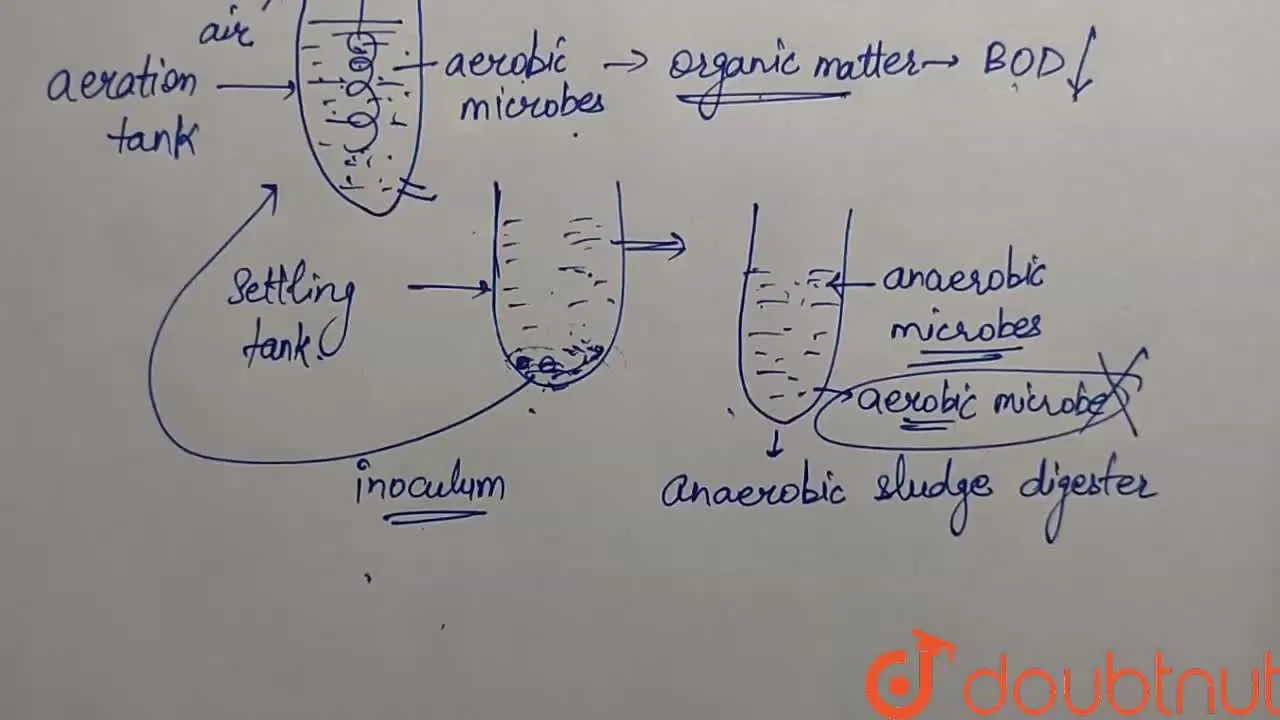Explain the role of microbes in the treatment of sewage.Solution in Punjabi
Sewage is the municipal waste water having human excreta and ofter organic wastes and various disease causing microbes.
It is made less polluting by passing it through STP (Sewage Treatment Plants).
There are 2 stages of treatment as follows-
1. Primary Treatment.
⇒ It removes floating and suspendid solids from sewage through two process-filtration and sedimentation.
⇒First floating matter (like polythene bags etc.), is removed through sequential filtration.
⇒ The filtrate is kept in large open settling tanks where grit (soil and small pebbles) settles down. The sediment is called primary sludge while the supernatant is called effluent.
⇒ The effluent from the primary settling is taken for secondary treatment.
2. Secondary Treatment. There are several methods of secondary treatment, e.g., oxidation tanks, trickling filter and activated sludge system.
⇒ In activated sludge system, the primary effluent is taken to aeration tanks where it is constantly agitated mechanically, Air is also pumped into it.
⇒ A large number of aerobic heterotrophic microbes grow in the aeration tank to form floes masses of bacteria, held together by sline and fungal filaments to form mesh like structures.
⇒ The microbes digest a lot of organic matter, converting it into microbial biomass and releasing a lot of minerals. As the
BOD (biochemical oxygen demand) of the waste matter is reduced to 10-15% of raw sewage, it is passed into settling tank where the bactrial floes undergo sedimentation.
⇒ The effluent is generally passed into natural waters like rivers and streams. BOD refers to the amount of oxygen that would be consumed, if all the organic matter in one litre of water were oxidised by bacteria.
⇒ The sediments of settling tank is called activated sludge. A part of it is used as inoculum in aeration tank. The remaining is passed into a large tank called anaerobic sludge digester.
⇒ Anaerobic microbes digest the organic mass as well as aerobic microbes of the sludge.
⇒ Methanbgenic bacteria produce a mixture of gases containing methane H2S and CO2. The mixture called biogas is inflammable and is a source of energy. The spent sludge can be used as manure or part of compost.
Related Playlists
- BOOK - BETTER CHOICE PUBLICATIONCHAPTER - MICROBES IN HUMAN WELFAREEXERCISE - LONG ANSWER TYPE QUESTIONS4videos
MICROBES IN HUMAN WELFARE
- BOOK - BETTER CHOICE PUBLICATIONCHAPTER - HUMAN REPRODUCTIONEXERCISE - LONG ANSWER TYPE QUESTIONS40videos
HUMAN REPRODUCTION
- BOOK - BETTER CHOICE PUBLICATIONCHAPTER - MOLECULAR BASIS OF INHERITANCEEXERCISE - MOST EXPECTED QUESTIONS36videos
MOLECULAR BASIS OF INHERITANCE
Similar Questions
Describe the process of Symbiotic Biological Nitrogen fixation.
07:00View SolutionWhere does Oogenesis occur in humans? Describe the stages of the process.
02:42View SolutionDefine genetic code.
02:42View SolutionMicrobes In Sewage Treatment
04:03View SolutionWhat is the role of microbes in sewage treatment plant?
37:06View SolutionWhat is the role of microbes in sewage treatment plant?
03:41View SolutionDescribe the role of Microbes in sewage treatment plant.
03:41View SolutionMICROBES IN SEWAGE TREATMENT
45:44View SolutionWrite a note on the role of microbes in sewage treatment.
02:59View SolutionDescribe briefly the role of microbes in sewage treatment.
02:33View SolutionMicrobes in Sewage Treatment
56:07View SolutionExplain the role of microbes in sewage treatment.
01:09:14View SolutionDescribe the role of microbes in Sewage treatment plant.
04:48View SolutionMicrobes in Sewage Treatment || Process of Sewage Treatment || Boo River Action Plants
04:14View SolutionMicrobes in Sewage Treatment || Microbes as BiOFertilizers
06:23View SolutionExplain the role of bacteria in sewage treatment.
06:23View Solution


